A Western everlasting

Call of Juarez: Gunslinger is celebrating its 10th anniversary this year. The game that concluded the series of Westerns from Techland was a memorable and unique project for our developers.
When recalling the production period, everyone unanimously emphasizes the interdisciplinary nature of the team, the unconventional storyline, and the originality that accompanied the development. Everyone also agrees that the game is still fun to play, despite the passage of time. Do you fancy a tale straight out of the Wild West? Go on ahead, then!
The first thing coming to mind when you think about Call of Juarez: Gunslinger is ..?
It’s the fact that at the beginning, the game wasn’t supposed to be what it turned out to be,
Kamil Braun, acting Lead Environment Artist during the production of Call of Juarez: Gunslinger, says with a laugh. It was supposed to be a detective game focused on finding clues. I recall that we created a visualization codenamed Back to the West. It featured a waterfall and a log cabin, and so we proceeded to create a story based on that. Or rather, it was Krzysztof Nosek (Producer) and Rafał Orkan (Game Writer) who started concocting the story,
Kamil Braun mentions.
At the old Techland headquarters, we had a room that we called the bunker as it had no windows, and it was quite dark in there. When I think of Call of Juarez: Gunslinger, my memories go back to when Rafał Orkan and I sat there and mulled over the story. I, as the Lead Level Designer at the time, had gathered all kinds of ideas for the design and presented Rafal with the plot, and he would add details to the story. There, amidst cigarette fumes (even though we smoked outside the office), we fine-tuned the game script,
recalls Adrian Sikora, currently the Game Producer.
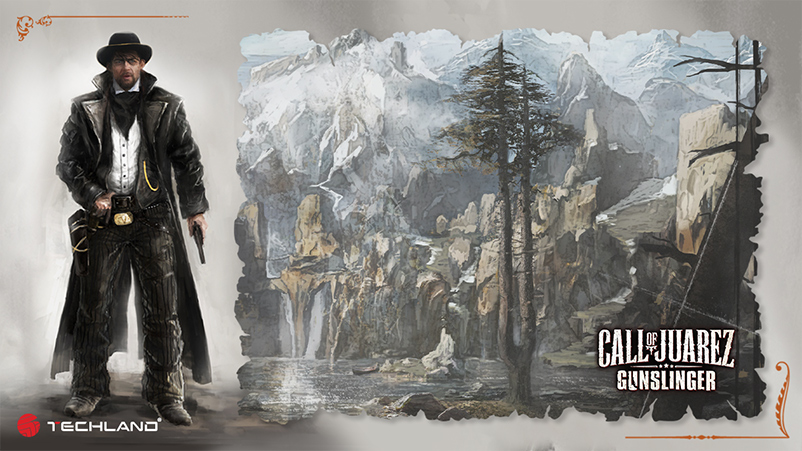
Working on Call of Juarez: Gunslinger is probably one of my best memories from Techland,
admits Piotr Wojtas, a Senior Level Artist. We created this game using scrum methodology, with a great deal of flexibility and decision-making on the team’s end. We used analog methods, meaning we would meet every morning, pieces of paper in our hands, and we would write down the tasks. We operated in a very democratic way. Each one of us had high qualifications, high ownership, and that feeling we were doing something that would eventually find its way into the game,
adds Piotr Wojtas.
The first thing I associate with Call of Juarez: Gunslinger is definitely the great team we developed the game with. I remember it was one of the first, if not the first interdisciplinary team at Techland. We were all in the same room: graphic designers, concept artists, level designers, and game designers. When an idea came up, we could discuss it right away and test it in the game the very next day,
recalls Artur Kowalczyk, the Lead Environment Artist. I remember we had a poster from The Good, the Bad and the Ugly hanging on the door to that room, too,
he laughs.
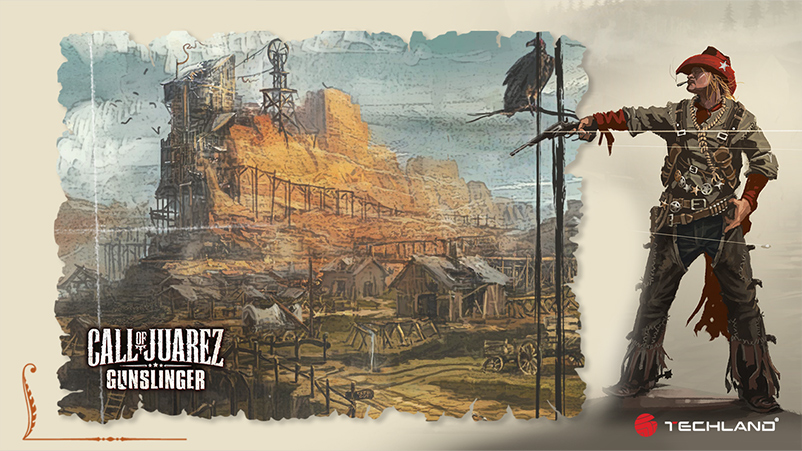
I find it a very nice and impressive game, first and foremost. Call of Juarez: Gunslinger is a fast-paced shooter very well done in terms of visuals with its comic-like aesthetic, a great feel for weapons, and fun gameplay,
says Jarosław Gąsior, the Principal Level Artist.
An Indie Project
In comparison to Techland’s recent productions, Call of Juarez was developed relatively quickly, in just a year and a half. It was a linear game, though, and as the developers state, incomparable to the studio’s later productions in terms of environment, exploration, and gameplay dependencies.
Looking at it today, it was more of an indie project rather than a AAA, released only digitally with no physical version. We worked in a small team and with no huge budget, but I think we produced a very good game with a great storyline, great music, and a real Wild West atmosphere,
says Kamil Braun.
I definitely recall Call of Juarez as an indie project. It was very much based on the fondness for the title and the team’s desire to create the game. After Call of Juarez: The Cartel, when it turned out that the team had a chance to develop yet another title in the series — and one meant to be ‘cool’ before all else — our developers put on their spurs, hats, saddled their horses, and charged on without a second thought,
Adrian Sikora recalls with a laugh. In that team, not one person worked on something because they had to. Gunslinger was created by people who loved the vibe of westerns and wished to make a good game set in the Wild West,
he adds.
Compared to our productions today, you could say it was a small project, and we had a lot of freedom,
says Artur Kowalczyk. The idea behind this production was to make something fun, where everyone could take responsibility for their own area while adding their own touch and have fun while at it,
he adds.
The project required technological agility as well. On the one hand, the team could experiment, but on the other, just like in indie productions, they had to get creative.
As a Level Artist, I was responsible for creating maps, from the terrain to the tiniest detail, like a bottle standing on a bar. I remember that we had cool ideas for technicalities such as rendering and terrain technology that we could implement,
recalls Jarosław Gąsior.
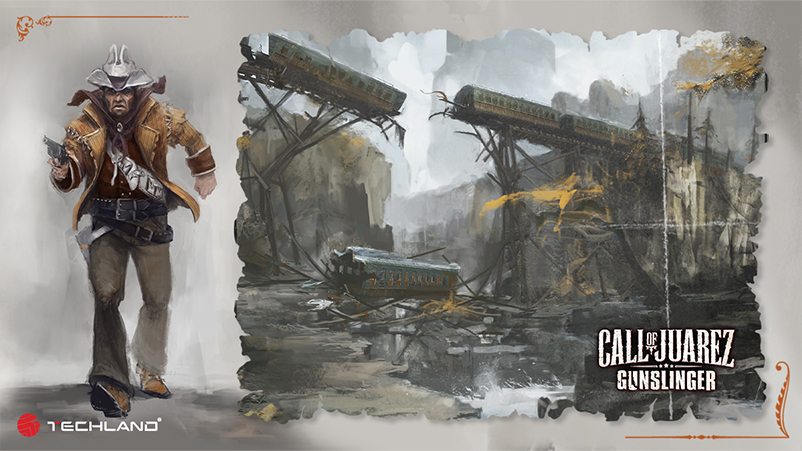
The team was relatively small, so we adhered to the ‘work smart’ principle and used assets in several different ways,
Kamil Braun recalls.
Piotr Wojtas agrees with him. We created the entire game with about 50 people, so we had to heavily optimize and get creative with the use of assets. I think, however, that this is one of those projects where ‘less is more’
, he concludes.
The Comic and Confabulation
What still sets Call of Juarez: Gunslinger apart from the other Techland productions is its distinctive comic-like aesthetic.
It was the only game in Techland’s library with a distinct visual style. Usually, we opt for heavy realism. Here, the aesthetics were strongly influenced by comic books, and as a result, the game has not aged at all,
says Jarosław Gąsior.
The idea of a saloon tale, however, wasn’t born right away.
I remember that for a long time, we didn’t really have an idea for Call of Juarez,
Adrian Sikora recalls. We started with the concept of free exploration in an open world. We pondered the idea that the player would take on the role of a gunfighter taking on various jobs, we had quite a bit of cool elements, but we lacked a strong main story idea. Every now and then, new ideas came up, but there were always some ‘buts’ until finally, the idea of a storyteller telling his stories in a saloon popped up,
recounts Adrian Sikora.
Gunslinger’s main plot line consists of 10 stories of Wild West outlaws, tied together by the eponymous gunslinger, Silas Greaves, who recounts his tales to patrons gathered in the saloon and, as befits a true storyteller, considerably spices up his tales.
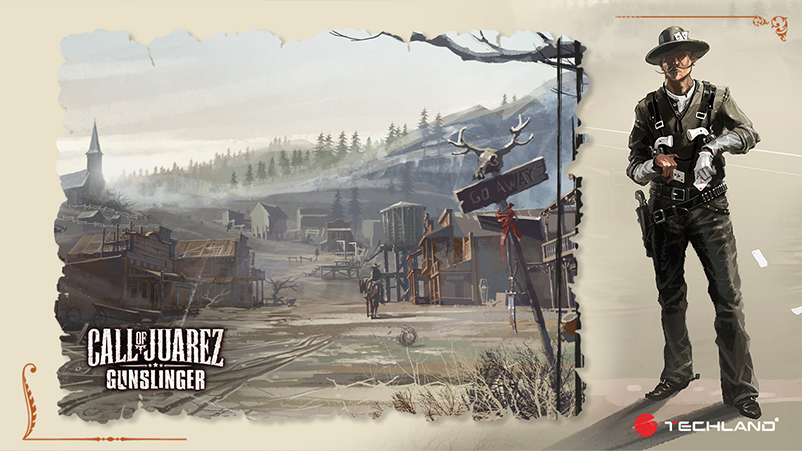
What was interesting about this project was how the environment changed as the story progressed. Along with the narrator’s tale and its corrections within the game’s storyline, we had to come up with dynamic environment changes. The narrative of Call of Juarez: Gunslinger, based on the narrator’s recollections not always consistent with the facts, gave us plenty of room for dynamic changes in the environment,
says Jarosław Gąsior.
While working on Call of Juarez: Gunslinger, we came up with ingenious ideas for addressing problems. For instance, we created a canyon, and the premise was to fight enemies shooting from above. In our concept, the player could not change that. But then, they were unable to escape from there. And then, the main character’s story is suddenly corrected, and we can initiate a change. By allowing Silas to chatter on, we could also afford to do so. It was fun and solved a lot of playability problems,
recalls Piotr Wojtas.
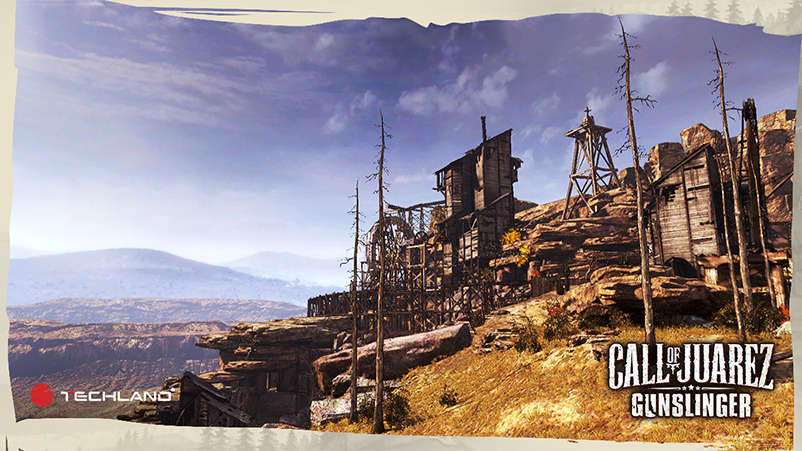
When creating the game environment, we relied on film, art, and comic book references. I remember we aimed for diversity. That’s why here we have a town, forests, caves, and even a moving train,
explains Kamil Braun. Black-powder firearms also gave ample room for narration,
he adds
What makes the game visually appealing despite the passage of time is the thick line art and its comic-like narrative. That makes Gunslinger feel like those classic animations: still enjoyable to watch, even though technology has significantly advanced,
concludes Adrian Sikora.
A steamboat cruise
There are several anecdotes related to the production as well. One of the most commonly mentioned is the steamboat.
The steamboat has definitely become a legend here at Techland,
Kamil Braun laughs. At first, the boat was supposed to be just a part of the scenery. Then, we decided it would be cool to be able to walk on it for the sake of the story, and finally, a mission was added where you have to escape from inside the boat. And so this asset kept growing, and as soon as I was close to finishing it, something else had to be added. But in the end, we succeeded and put that steamboat in there.
To this day, I still ask Kamil when the steamboat will finally be done,
Adrian Sikora laughs.
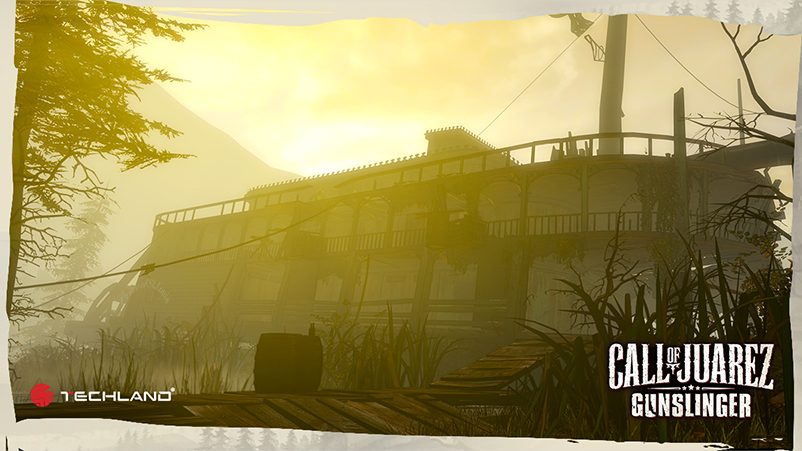
He also recalls the unexpected prize for the game.
We were at Digital Dragons at the time, and when the name Call of Juarez: Gunslinger was announced during the awards for the Polish game of the year 2013, we were so shocked that we didn’t know who should go on stage to receive it. In the end, Kamil Braun and Jacek Matuszewski undertook the task,
recalls Adrian Sikora.
What has Gunslinger etched in Techland’s legacy?
While working on Call of Juarez: Gunslinger, I learned one important thing: you can be a great specialist in game development, but without a broader perspective, you won’t be able to go beyond imitative stuff,
states Piotr Wojtas. Gunslinger’s narrative has a touch of humor and a degree of tongue-in-cheek casualness, but it’s based on true stories and very much set in the context of the Wild West. That’s what gives it the dash of originality. Along with the voices, hand-drawn slides, great sound design, and very good shooting mechanics, we created several hours of really good entertainment,
he adds.
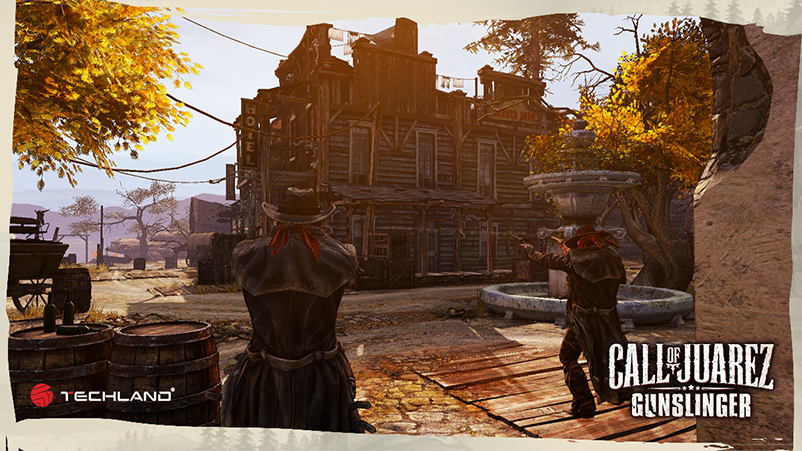
Gunslinger was a very nice conclusion to the Call of Juarez series, but at that point in time, it was no longer a game from the canon we have since forged at Techland,
says Adrian Sikora. We were already involved in productions centered around a strong gameplay, invested in co-op, and were branching out into the development of survival horror games,
he adds.
To me, Gunslinger is about closing a certain chapter at Techland. Namely, it’s the end of linear shooters,
says Jarosław Gąsior.
The game was released on Nintendo Switch in 2019. Learn more about the Call of Juarez series at Techland Store.